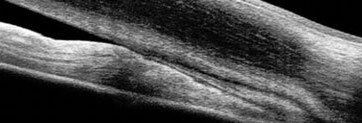 |
Risk factors for PACD—which may lead to angle-closure glaucoma—include older age, higher IOP and more shallow anterior chamber depth. Photo: Michael Cymbor, OD. Click image to enlarge. |
More than 77% of patients with primary angle-closure glaucoma (PACG) are Asian. The visual outcomes of this form of glaucoma can be devastating, and compared with open-angle glaucoma, the condition is associated with a three-fold increased risk of severe bilateral vision impairment. Its prevalence is also increasing globally, and particularly in Asia, it is emerging as a serious public health concern. Less is known about the incidence and progression of primary angle-closure disease (PACD), which precedes PACG.
To gain a better understanding of the incidence and risk factors of PACD in a multi-ethnic Asian population, researchers analyzed data over six years from the Singapore Epidemiology of Eye Diseases study, a population-based cohort study that included participants aged 40 or older living in Singapore. All completed ophthalmic examinations at baseline and six-year follow-up visits. Of 6,762 participants with data from both examinations, those included in the analysis were the 5,298 at risk for PACG and 5,060 at risk for PACD.
The six-year age-adjusted PACD incidence in the cohort was 3.5%. For PACG, primary angle-closure and primary angle-closure suspect, it was 0.29%, 0.46% and 2.54%, respectively. In addition, the team found that 9.38% of primary angle-closure suspects progressed to primary angle-closure or PACG over the six-year period.
Several baseline parameters were identified as risk factors for PACD development, including increasing age per decade (odds ratio: 1.35), higher intraocular pressure (odds ratio) and shallower anterior chamber depth (odds ratio: 1.11). On the other hand, late posterior subcapsular cataract was associated with a decreased likelihood of developing PACD (odds ratio: 0.60).
Another important finding: as the rate of cataract surgeries increased, the number of patients who developed PACD decreased. “Studies have shown that cataract removal is associated with a deeper anterior chamber depth and wider anterior chamber angles, which subsequently reduces the risk of PACD,” the researchers wrote. As an example, they pointed to the former Liwan Eye study, where “the highest PACD incidence observed could be largely explained by the much lower rate of cataract surgery reported in the study.”
Although age was shown to be a significant risk factor for PACD in this study, it, along with gender, didn’t have a significant effect on progression across disease stages.
The researchers concluded, “These findings may aid clinicians in deciding the frequency of monitoring or urgency of treatment and patient counseling.” In addition, they suggested the data could help “policy administrators ensure adequate resources are allocated to screening and intervention initiatives to address angle-closure glaucoma-related vision impairment.”
Teo ZL, Da Soh Z, Tham YC, et al. Six-year incidence and risk factors for primary angle closure disease: the Singapore Epidemiology of Eye Diseases study. Ophthalmology. March 9, 2022. [Epub ahead of print]. |

